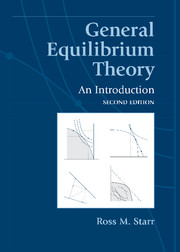Book contents
- Frontmatter
- Contents
- List of illustrations
- Introduction to the second edition
- Preface to the second edition
- Preface to the first edition
- Table of notation
- Table of assumptions
- A General equilibrium theory: Getting acquainted
- B Mathematics
- C An economy with bounded production technology and supply and demand functions
- 10 Markets, prices, commodities, and mathematical economic theory
- 11 Production with bounded-firm technology
- 12 Households
- 13 A market economy
- 14 General equilibrium of the market economy with an excess demand function
- D An economy with unbounded production technology and supply and demand functions
- E Welfare economics and the scope of markets
- F Bargaining and equilibrium: The core
- G An economy with supply and demand correspondences
- H Standing on the shoulders of giants
- Bibliography
- Index
10 - Markets, prices, commodities, and mathematical economic theory
from C - An economy with bounded production technology and supply and demand functions
Published online by Cambridge University Press: 05 June 2012
- Frontmatter
- Contents
- List of illustrations
- Introduction to the second edition
- Preface to the second edition
- Preface to the first edition
- Table of notation
- Table of assumptions
- A General equilibrium theory: Getting acquainted
- B Mathematics
- C An economy with bounded production technology and supply and demand functions
- 10 Markets, prices, commodities, and mathematical economic theory
- 11 Production with bounded-firm technology
- 12 Households
- 13 A market economy
- 14 General equilibrium of the market economy with an excess demand function
- D An economy with unbounded production technology and supply and demand functions
- E Welfare economics and the scope of markets
- F Bargaining and equilibrium: The core
- G An economy with supply and demand correspondences
- H Standing on the shoulders of giants
- Bibliography
- Index
Summary
Commodities and prices
We've seen examples of general equilibrium economic systems characterized by N commodities for N = 2 (Robinson Crusoe in Chapter 2; Edgeworth box in Chapter 3), N = 4 (2 × 2 × 2) in Chapter 4, and arbitrary positive integer N in Chapter 5. Chapters 6 through 9 summarized the mathematics suitable for analyzing these economies using RN as the commodity space. To represent a list of quantities of N goods, we'll use a point in RN. The expression x = (x1, x2, x3, …, xN) represents a commodity bundle. That is, x is a shopping list: x1 of good 1, x2 of good 2, and so forth through xN of good N. The coordinates xn (n = 1, 2, …, N) may be either positive or negative (subject to interpretation).
The price system consists of an N-tuple p = (p1, p2, …, pN). Let pn ≥ 0 for all n = 1, …, N. The value of a bundle x ∈ RN at prices p is p · x.
What are these N commodities? That turns out to be rather a deeper question than it appears, so a full discussion will be postponed until Chapter 20.
The formal structure of pure economic theory
The plan for the rest of this book is to develop a formal mathematical model of a market economy. Professor Debreu describes below some of the strengths of this approach.
- Type
- Chapter
- Information
- General Equilibrium TheoryAn Introduction, pp. 112 - 114Publisher: Cambridge University PressPrint publication year: 2011



